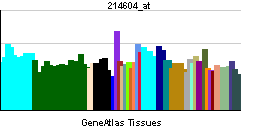HOXD11
| Homeobox D11 | |||||||||||
|---|---|---|---|---|---|---|---|---|---|---|---|
| Identifiers | |||||||||||
| Symbols | HOXD11 ; HOX4; HOX4F | ||||||||||
| External IDs | Template:OMIM5 Template:MGI HomoloGene: 7368 | ||||||||||
| |||||||||||
| RNA expression pattern | |||||||||||
 | |||||||||||
| More reference expression data | |||||||||||
| Orthologs | |||||||||||
| Template:GNF Ortholog box | |||||||||||
| Species | Human | Mouse | |||||||||
| Entrez | n/a | n/a | |||||||||
| Ensembl | n/a | n/a | |||||||||
| UniProt | n/a | n/a | |||||||||
| RefSeq (mRNA) | n/a | n/a | |||||||||
| RefSeq (protein) | n/a | n/a | |||||||||
| Location (UCSC) | n/a | n/a | |||||||||
| PubMed search | n/a | n/a | |||||||||
Homeobox D11, also known as HOXD11, is a human gene.[1]
This gene belongs to the homeobox family of genes. The homeobox genes encode a highly conserved family of transcription factors that play an important role in morphogenesis in all multicellular organisms. Mammals possess four similar homeobox gene clusters, HOXA, HOXB, HOXC and HOXD, located on different chromosomes, consisting of 9 to 11 genes arranged in tandem. This gene is one of several homeobox HOXD genes located in a cluster on chromosome 2. Deletions that remove the entire HOXD gene cluster or the 5' end of this cluster have been associated with severe limb and genital abnormalities. The product of the mouse Hoxd11 gene plays a role in axial skeleton development and forelimb morphogenesis.[1][2][3][4]
See also
References
- ↑ 1.0 1.1 "Entrez Gene: HOXD11 homeobox D11".
- ↑ Davis AP, Capecchi MR.Axial homeosis and appendicular skeleton defects in mice with a targeted disruption of hoxd-11. Development. 1994 Aug;120(8):2187-98. PMID:7925020
- ↑ Davis AP, Witte DP, Hsieh-Li HM, Potter SS, Capecchi MR.Absence of radius and ulna in mice lacking hoxa-11 and hoxd-11. Nature. 1995 Jun 29;375(6534):791-5. PMID:7596412
- ↑ Davis AP, Capecchi MR.A mutational analysis of the 5' HoxD genes: dissection of genetic interactions during limb development in the mouse. Development. 1996 Apr;122(4):1175-85. PMID:8620844
Further reading
- Johnson RL, Tabin CJ (1997). "Molecular models for vertebrate limb development". Cell. 90 (6): 979–90. PMID 9323126.
- Goodman FR (2003). "Limb malformations and the human HOX genes". Am. J. Med. Genet. 112 (3): 256–65. doi:10.1002/ajmg.10776. PMID 12357469.
- Scott MP (1992). "Vertebrate homeobox gene nomenclature". Cell. 71 (4): 551–3. PMID 1358459.
- McAlpine PJ, Shows TB (1990). "Nomenclature for human homeobox genes". Genomics. 7 (3): 460. PMID 1973146.
- Acampora D, D'Esposito M, Faiella A; et al. (1990). "The human HOX gene family". Nucleic Acids Res. 17 (24): 10385–402. PMID 2574852.
- Shen WF, Montgomery JC, Rozenfeld S; et al. (1997). "AbdB-like Hox proteins stabilize DNA binding by the Meis1 homeodomain proteins". Mol. Cell. Biol. 17 (11): 6448–58. PMID 9343407.
- Hérault Y, Beckers J, Gérard M, Duboule D (1999). "Hox gene expression in limbs: colinearity by opposite regulatory controls". Dev. Biol. 208 (1): 157–65. doi:10.1006/dbio.1998.9179. PMID 10075849.
- Del Campo M, Jones MC, Veraksa AN; et al. (1999). "Monodactylous limbs and abnormal genitalia are associated with hemizygosity for the human 2q31 region that includes the HOXD cluster". Am. J. Hum. Genet. 65 (1): 104–10. PMID 10364522.
- Limongi MZ, Pelliccia F, Gaddini L, Rocchi A (2000). "Clustering of two fragile sites and seven homeobox genes in human chromosome region 2q31-->q32.1". Cytogenet. Cell Genet. 90 (1–2): 151–3. PMID 11060466.
- Patterson LT, Pembaur M, Potter SS (2001). "Hoxa11 and Hoxd11 regulate branching morphogenesis of the ureteric bud in the developing kidney". Development. 128 (11): 2153–61. PMID 11493536.
- Goodman FR, Majewski F, Collins AL, Scambler PJ (2002). "A 117-kb microdeletion removing HOXD9-HOXD13 and EVX2 causes synpolydactyly". Am. J. Hum. Genet. 70 (2): 547–55. PMID 11778160.
- Taketani T, Taki T, Shibuya N; et al. (2002). "The HOXD11 gene is fused to the NUP98 gene in acute myeloid leukemia with t(2;11)(q31;p15)". Cancer Res. 62 (1): 33–7. PMID 11782354.
- Kosaki K, Kosaki R, Suzuki T; et al. (2002). "Complete mutation analysis panel of the 39 human HOX genes". Teratology. 65 (2): 50–62. doi:10.1002/tera.10009. PMID 11857506.
- Boulet AM, Capecchi MR (2002). "Duplication of the Hoxd11 gene causes alterations in the axial and appendicular skeleton of the mouse". Dev. Biol. 249 (1): 96–107. PMID 12217321.
- Strausberg RL, Feingold EA, Grouse LH; et al. (2003). "Generation and initial analysis of more than 15,000 full-length human and mouse cDNA sequences". Proc. Natl. Acad. Sci. U.S.A. 99 (26): 16899–903. doi:10.1073/pnas.242603899. PMID 12477932.
- Zhao X, Sun M, Zhao J; et al. (2007). "Mutations in HOXD13 underlie syndactyly type V and a novel brachydactyly-syndactyly syndrome". Am. J. Hum. Genet. 80 (2): 361–71. doi:10.1086/511387. PMID 17236141.
External links
- HOXD11+protein,+human at the US National Library of Medicine Medical Subject Headings (MeSH)
This article incorporates text from the United States National Library of Medicine, which is in the public domain.
| This protein-related article is a stub. You can help Wikipedia by expanding it. |